 |
 |
 |
| |
INTRAVAGINAL RING DELIVERY OF THE PYRIMIDINEDIONE IQP-0528 RESULTS IN PROTECTIVE CONCENTRATIONS IN VAGINAL BIOPSIES OF
PIGTAILED MACAQUES - NOVEL MODELS TO ASSESS PK/PD
|
| |
| |
Reported by Jules Levin
CROI 2012
Pedro M. Mesquita1, Rachna Rastogi2, Todd J. Johnson2, Priya Srinivasan3, James M. Smith3, Robert W. Buckheit Jr.4, Patrick F. Kiser2, and Betsy C. Herold1
1Department of Pediatrics, Albert Einstein College of Medicine, Bronx, NY, US; 2Department of Bioengineering, University of Utah, Salt Lake City, UT, US; 3Division of HIV/AIDS Prevention, Centers for
Disease Control and Prevention, Atlanta, GA, US; 4ImQuest BioSciences, Frederick, MD, US
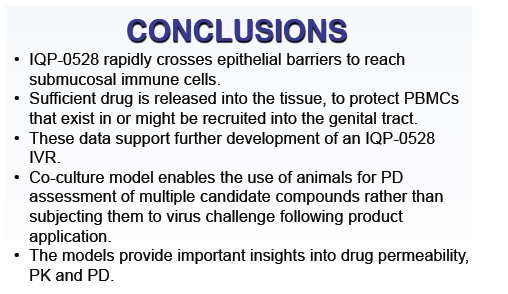
ABSTRACT
Intravaginal Ring Delivery of the Pyrimidinedione IQP-0528 Results in Protective Concentrations in Vaginal Biopsies of Pigtailed Macaques, Novel Models to Assess Pharmacokinetics/Pharmacodynamics
Pedro Mesquita1, R Rastogi2, T Johnson2, P Srinivasan3, J Smith3, R Buckheit III4, P Kiser2, and B Herold1
1Albert Einstein Coll of Med, Bronx, NY, US; 2Univ of Utah, Salt Lake City, US; 3CDC, Atlanta, GA, US; and 4ImQuest BioSci, Frederick, MD, US
Background: The lack of biomarkers predictive of efficacy and safety is a major gap in topical pre-exposure prophylaxis (PrEP) development. High costs and limited access to animals are significant limitations with non-human primate (NHP) SHIV models. In addition, poor reproducibility of ex vivo HIV or SHIV challenge of human or NHP cervical and vaginal biopsies highlights the need for new models.
Methods: We used a dual-chamber model with polarized epithelial cells to evaluate the bio-permeability and pharmacokinetics/pharmacodynamics (PK/PD) of an intravaginal ring (IVR) formulation of IQP-0528, a pyrimidinedione with potent reverse transcriptase inhibitory activity against HIV-1/2. Cells were apically exposed to mini-IVR and basolateral supernatants were collected and analyzed for drug level and ability to inhibit HIV-1BaL infection of TZM-baseline cells. IVR loaded with 10 wt% IQP-0528 (n = 6), or placebo (n = 2), were inserted into pigtailed macaques. Vaginal biopsies were collected prior to and 7 and 14 days post-IVR insertion. IQP-0528 tissue levels were determined by LC-MS/MS. The ability of the biopsied tissue to function as a drug reservoir and block infection of PBMC was evaluated by co-culturing minced biopsies with activated human PBMC prior to challenge with 103 TCID50 HIV-1BaL.
Results: IQP-0528 released from IVR crossed the epithelial barrier at a rate comparable to that observed in the absence of epithelial cells and sufficient drug was present within 24 hours in basolateral compartments to abrogate HIV infection. Co-cultures of biopsies collected from 6 of 6 animals exposed to IQP-0528 IVR were protected from HIV or RT-Env-SHIV challenge compared to baseline, whereas no protection was observed in 2 of 2 animals exposed to placebo IVR. The concentration of drug in proximal and distal biopsies 14 days post application was 20.2±14.9 and 10.4±11.8 ng/mg tissue, respectively (NS, p = 0.24). There was a significant PK /PD correlation (r2 = 0.77).
Conclusions: The dual-chamber model suggests that IQP-0528 rapidly crosses epithelial barriers to reach submucosal immune cells and NHP studies indicate that sufficient drug is released into the tissue, to protect PBMC that exist in or might be recruited into the genital tract. These data support further development of an IQP-0528 IVR. Moreover, the models provide important insights into drug permeability, PK and PD. Biopsies from planned human safety trials of pyrimidinediones should be evaluated in the co-culture model.
BACKGROUND
The predominant mode of HIV transmission is sexual intercourse, with infection disproportionately impacting young
women. Therefore the development of safe and efficacious topically applied prophylactic formulations (topical PrEP) for
prevention of HIV is a critical health priority. The lack of biomarkers predictive of efficacy and safety is a major gap in
microbicide development and the failures in prior large scale clinical trials highlight the need for better correlates of protection.
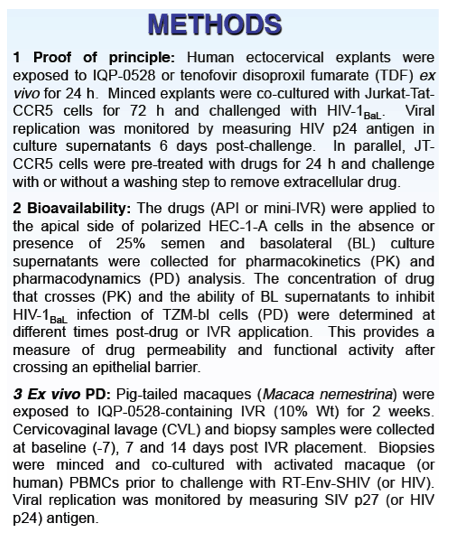
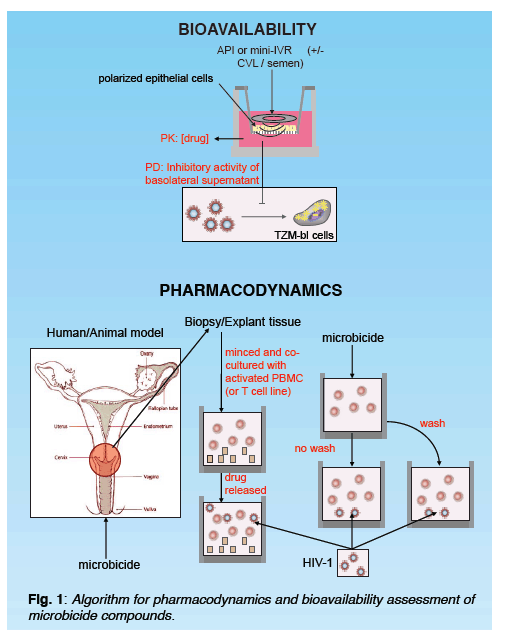
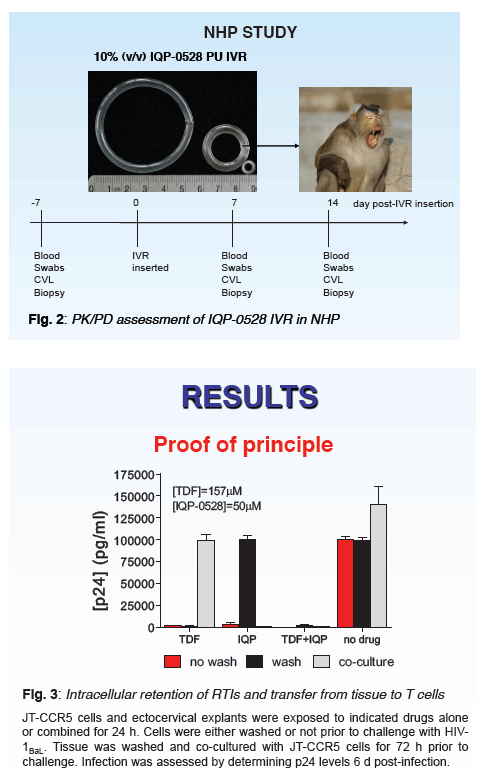
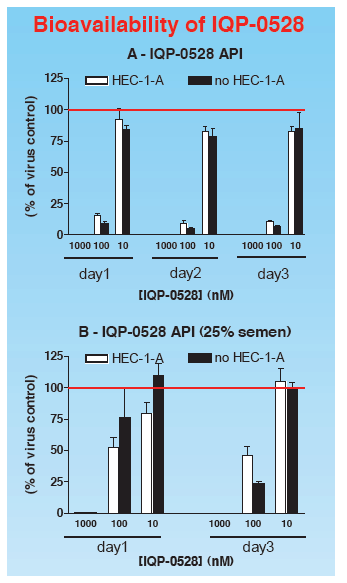
Challenging non-human primates (NHP) with SHIV is considered by many a prerequisite for advancement of new
products into the clinic, but the number of animals available and the associated high costs, limit the feasibility of NHP challenge experiments. In addition, the lack of reproducibility in vaginal and cervical biopsy infection warrants the development of novel methods to evaluate microbicide pharmacodynamics (PD).
The amount of target cells for HIV present in cervical biopsies is highly variable, thus direct challenge is difficult and not very reproducible. We hypothesized that microbicide PD could be assessed by obtaining cervical biopsies from animals treated with candidate drugs and then challenging the tissue ex vivo with virus to determine whether sufficient drug has been delivered to the tissue and whether it retains biological activity.
We used a novel co-culture system to study microbicide PD ex vivo following treatment of NHP with intravaginal rings (IVR) for sustained delivery of the pyrimidinedione IQP-0528, a potent reverse transcriptase inhibitor with additional activity against entry of HIV.
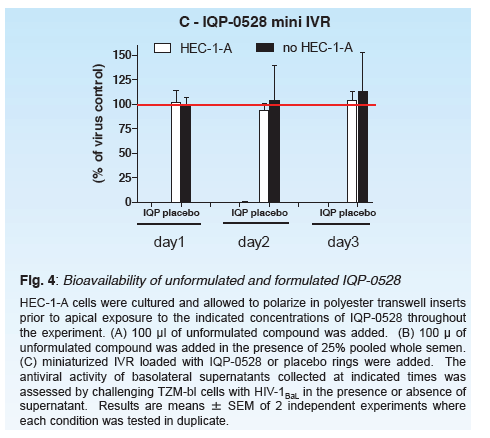
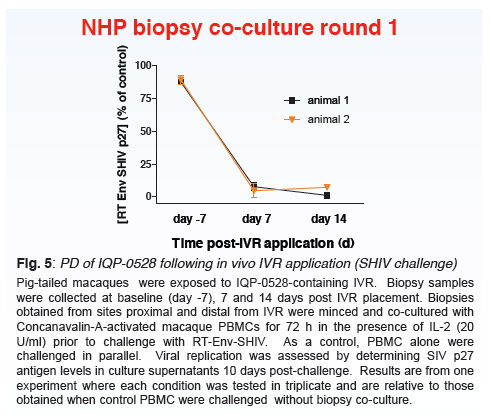
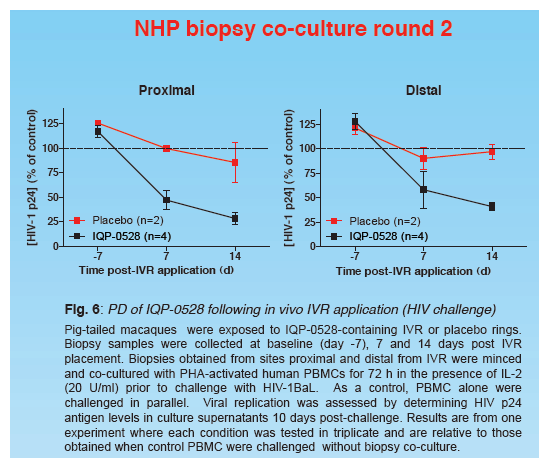
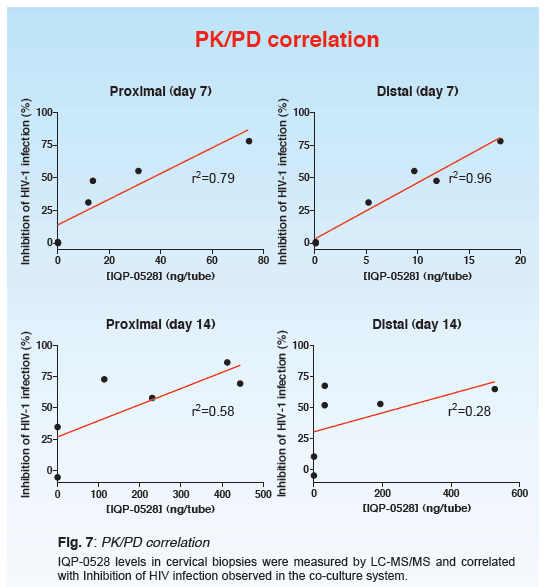
|
| |
|
 |
 |
|
|